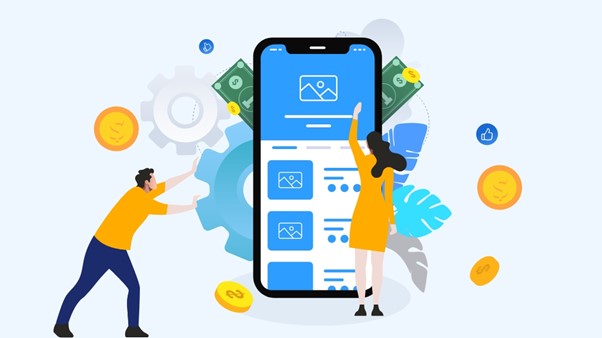XR Digital
At XR Digital, we blend creativity, technology, and strategy to deliver unparalleled digital solutions. Explore the possibilities with us as we push the boundaries of innovation and transform your vision into reality.

In the fast-paced world of mobile applications, the significance of refining app ideas cannot be overstated. A well-thought-out, thoroughly refined app idea is the cornerstone of successful development and deployment.
It serves as the blueprint for the entire project, influencing everything from design and functionality to user experience and market reception. The competitive landscape is ever evolving, with millions of apps vying for attention across various platforms. Without a carefully refined idea, your app risks being lost in the sea of digital offerings.
You also need to stay informed about technological trends such as virtual reality in healthcare, VR app development, and artificial intelligence. Integrating these innovations can enhance your app’s functionality and user experience.
This article aims to guide aspiring app developers and entrepreneurs through the process of refining their app ideas, offering insights into crucial steps and considerations that can make the difference between an app that flounders and one that thrives.

Developing an app is a multifaceted endeavor, and challenges can emerge at various stages. Acknowledging these challenges is the first step toward finding effective solutions.
The proliferation of apps across app stores makes it challenging to carve out a unique space. Understanding the competitive landscape is vital for refining your app idea and ensuring it offers something distinctive.
Users today have high expectations when it comes to app experiences. Identifying and meeting these expectations requires thorough research and a user-centric approach throughout the development process.
Choosing the right technology stack is a critical decision that can impact the performance and scalability of your app. Navigating technological constraints involves staying informed about the latest developments and selecting tools that align with your app’s goals.
App development often comes with budget constraints. Entrepreneurs need to refine their app ideas to fit within the available resources, exploring cost-effective solutions without compromising on quality.

The Unique Value Proposition (UVP) is the distinctive advantage or benefit that sets your app apart from others in the market. It’s the answer to the question: Why should users choose your app over the competition? Defining a clear and compelling UVP is crucial for several reasons.
In a saturated app market, a Unique Value Proposition (UVP) is crucial for market differentiation. It not only attracts users initially but ensures long-term engagement by addressing their needs and providing a distinctive experience. A clear UVP acts as a competitive edge, making your app memorable and compelling compared to others in a crowded landscape.
To define a compelling UVP, you must understand your competitors and what they offer. Conduct a thorough analysis of similar apps in your niche to identify gaps and opportunities.
In the competitive landscape of app development, a thorough competitor analysis is vital. Identifying key players in your niche, analyzing their features, design, and user experience, and assessing their strengths and weaknesses provide essential insights.
Your app’s features play a crucial role in delivering the promised value to users. Highlight features that contribute to your UVP and set your app apart.
To ensure your app’s success, focus on core features that align with your Unique Value Proposition (UVP) and cater to user needs. Integrate innovative features beyond expectations, enhancing the user experience with unique functionalities. Prioritize user-centric design, making the app intuitive and enjoyable. Incorporate elements for a positive overall experience.

A SWOT analysis is a strategic planning tool used to identify and evaluate the Strengths, Weaknesses, Opportunities, and Threats of a business or project. In the context of app development, a SWOT analysis provides a comprehensive view of both internal and external factors that can impact the success of your app.
Evaluate your team’s strengths, including technical expertise and creative skills, providing a competitive edge. Acknowledge internal weaknesses, identifying areas for improvement or additional resources to enhance your app’s development and performance. This strategic analysis lays the foundation for informed decisions and successful app refinement.
When refining your app idea, assess external opportunities by exploring market trends, unmet needs, and competitor gaps. Consider leveraging technological advancements and partnerships. Anticipate external threats from competitors, market changes, and technological disruptions, addressing challenges related to user security, data privacy, and evolving user preferences.
Strategic decision-making based on SWOT analysis insights allows for informed choices, capitalizing on strengths and opportunities while addressing weaknesses and threats. Resource allocation aligns with identified strengths and opportunities, prioritizing areas to overcome weaknesses and mitigate threats. Embracing adaptability and innovation, the SWOT analysis becomes a foundation for ongoing improvements and staying responsive to the environment.

Prototyping and wireframing play a pivotal role in bringing your app idea from conceptualization to tangible realization. These processes involve creating visual representations of your app’s interface and functionality, offering a preview of the user experience. The importance of visualizing your app idea cannot be overstated, as it provides a tangible foundation for communication, feedback, and refinement.
When embarking on the journey of prototyping, consider it as the initial sketch of your app. It’s a low-fidelity representation that captures the fundamental layout and navigation. This allows stakeholders, including developers, designers, and potential users, to grasp the core concept without investing significant time or resources.
Wireframing takes the concept a step further, providing a more detailed visual blueprint of your app. It includes the placement of buttons, navigation flow, and essential elements, offering a clearer picture of how users will interact with the application.

Choosing the right technical foundation is a pivotal aspect of refining your app idea. The technology stack you select influences the app’s performance, scalability, and overall success. As you navigate this critical phase, several considerations should guide your decision-making process.
Begin by assessing the nature and requirements of your app. Different types of applications, whether they are mobile, web, or a combination, may demand specific technologies. Consider factors such as the complexity of features, real-time interactions, and potential integration with external systems.
Decide on the technology stack for your app, considering factors like React Native pros and cons, Unity pros and cons, and the debate between hybrid apps vs. native apps. Choose a framework that aligns with your development goals.
Integration capabilities are another crucial aspect. Consider whether your app needs to connect with other systems, databases, or external APIs. A seamless integration enhances the overall user experience and expands the functionality of your app.

Monetizing your app is a crucial aspect of ensuring its sustainability and long-term success. There are various monetization models available, each with its advantages and considerations. Understanding these strategies and aligning them with your app’s unique value proposition is essential for building a profitable venture.
The freemium model offers a free version of your app with limited features, enticing users to upgrade to a premium or subscription-based version for additional functionalities. This approach allows you to attract a broad user base while generating revenue from users willing to pay for enhanced features.
Under the subscription model, users pay a recurring fee, typically on a monthly or annual basis, to access your app’s premium features. This model provides a steady stream of revenue and encourages user loyalty through ongoing value delivery.
The freemium model offers a free version of your app with limited features, enticing users to upgrade to a premium or subscription-based version for additional functionalities. This approach allows you to attract a broad user base while generating revenue from users willing to pay for enhanced features.
In-app purchases involve offering virtual goods, services, or premium content within your app. Users can make one-time purchases or buy virtual items to enhance their app experience. This model is prevalent in gaming apps but can be adapted to various genres.
Advertising is a common monetization strategy, where you display ads within your app and earn revenue based on user interactions or impressions. Ad-supported apps are accessible to a wider audience, but careful consideration is needed to balance user experience and ad placement.

The concept of a Minimum Viable Product (MVP) is a cornerstone in the iterative development process of refining your app idea. An MVP is a scaled-down version of your app that includes the essential features needed to address the core needs of your target audience.
The MVP serves as a tangible representation of your app idea, enabling you to assess its market reception and address potential issues proactively. User feedback becomes a crucial element in refining your app, guiding you in prioritizing feature enhancements, fixing bugs, and ensuring a more user-centric experience.
The iterative nature of building an MVP aligns with the agile development methodology, emphasizing flexibility and adaptability. As you release successive iterations, each incorporating user feedback and insights, your app becomes more refined and aligned with the evolving needs of your user base.

Case studies also shed light on the challenges faced by developers. Issues such as hardware limitations, user feedback, and unexpected technical hurdles are common in the dynamic field of VR app development. Learning from these challenges enables developers to anticipate potential issues and implement effective solutions in their projects.

In this comprehensive guide, we’ve navigated through the intricate process of refining your app idea, acknowledging the challenges and providing insights into crucial steps for success. From understanding the problem statement to continuously adapting in response to market changes, each phase plays a vital role in shaping your app into a valuable and sustainable product.
In conclusion, refining your app idea is a dynamic and ongoing process that demands strategic thinking, adaptability, and a relentless commitment to meeting user needs. By following the steps outlined in this guide, you’re not only refining your app but setting the stage for long-term success in the ever-evolving world of app development. Good luck on your journey to creating a successful and impactful app!
As XR Digital continues to push the frontiers of immersive technology, We closely examining your business objectives, our experts propose effective solutions to bring your business to new heights.
XR Digital thrives on developing immersive and personalized experiences that meet the changing needs of its users. XR Digital is committed to providing unique and memorable digital interactions. The emphasis on completing a SWOT analysis to support decision-making is consistent with XR Digital’s strategic approach to technology, which ensures a solid basis for ongoing advancements.
Yes, buying an existing app can be a viable way to make money. Before purchasing, conduct thorough due diligence on the app’s performance, user base, and revenue model. Assess its potential for improvement and growth.
To enhance your app idea, focus on understanding your target audience deeply. Conduct market research to identify trends and user needs. Refine your Unique Value Proposition (UVP) to address specific pain points. Utilize prototyping and wireframing for visual clarity.
Transforming your idea into an app involves several steps. Start by creating a detailed plan, including defining your target audience and outlining key features. Choose a suitable technology stack. Develop wireframes and prototypes to visualize the app. Build a Minimum Viable Product (MVP) for initial testing. Collaborate with developers to bring your idea to life. Implement effective marketing strategies for launch.
Yes, it is possible to sell an app idea, but the process can be challenging. Before pitching your idea, consider obtaining legal protection through patents or non-disclosure agreements. Create a compelling pitch with a clear Unique Value Proposition (UVP) and market potential.
At XR Digital, we blend creativity, technology, and strategy to deliver unparalleled digital solutions. Explore the possibilities with us as we push the boundaries of innovation and transform your vision into reality.
5 Responses